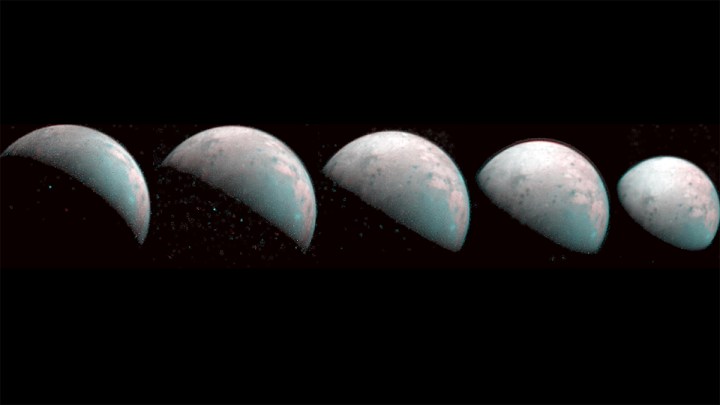NASA’s Juno spacecraft has imaged Ganymede, Jupiter’s largest moon, and has captured images showing how its unusual magnetic field affects the ice at its poles.
Juno passed by Ganymede on December 26, 2019, and its path took it over the top of the never-before-mapped northern pole of the moon. The Juno team knew this would be a rare opportunity to observe the moon up close and personal, so they prepared by turning the craft so its instruments faced the surface of the moon.
Juno came within just 62,000 miles of Ganymede and used its Jovian Infrared Auroral Mapper (JIRAM) instrument to collect 300 infrared images of the moon’s surface, which were used to create the infrared map of the northern part of the moon.

These images reveal activity on Ganymede, which does not have an atmosphere but, like Earth, does have a magnetic field. This magnetic field interacts with energetic particles given off by the sun, called plasma, which is channeled toward the moon’s poles and impacts the ice there.
“The JIRAM data show the ice at and surrounding Ganymede’s north pole has been modified by the precipitation of plasma,” Alessandro Mura, a Juno co-investigator at the National Institute for Astrophysics in Rome, said in a statement. “It is a phenomenon that we have been able to learn about for the first time with Juno because we are able to see the north pole in its entirety.”
The instrument used to capture these images, JIRAM, is capable of using infrared to look through Jupiter’s cloud layer and to see 30 to 45 miles beneath the clouds, but it can also be used for investigating Jupiter’s moons including Io, Europa, and Callisto as well as Ganymede.
“These data are another example of the great science Juno is capable of when observing the moons of Jupiter,” Giuseppe Sindoni, program manager of the JIRAM instrument for the Italian Space Agency, said in the statement.
This works paves the way for the European Space Agency’s JUpiter ICy moons Explorer, or JUICE, mission which is set to visit these moons in 2030 following its launch in 2022.
Editors' Recommendations
- Psyche spacecraft sends data back to Earth using lasers for the first time
- U.S. spacecraft lands on the moon for the first time in over 50 years
- NASA’s Lucy spacecraft will soon make its first flyby of an asteroid
- NASA’s first crewed test flight of Starliner spacecraft delayed
- There’s a problem with the Juno spacecraft’s camera




